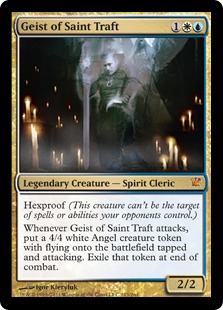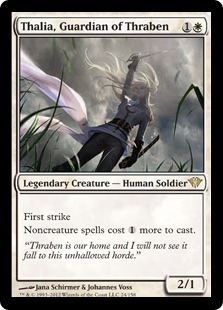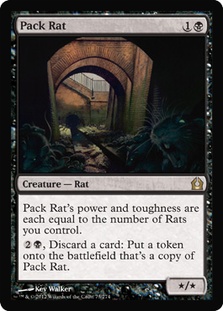This past weekend I got killed at Grand Prix Chicago, so I decided to take the opportunity to try out my Bant Control deck in a 5K Standard tournament. I did this largely to see if the rumors that I’d have trouble finishing rounds with the deck were true.
It turns out they were not. I didn’t have any draws, and I split the Top 8 of the tournament.
My deck felt very good, particularly against other Bant decks and aggressive decks. Unfortunately, it felt pretty bad against the only deck I lost to: U/W Flash.
That’s a pretty big only hole. It’s something like being good against everything but Delver last season, which is where I felt my U/W Midrange deck was. Once again, I have a deck that beats everything but the best deck. That’s too bad.
Oh, yes, have you gotten the memo? It’s official now, for the moment, that U/W Flash is the best deck. Gerry said Adam broke it, and the exact list from Adam Prosak article won the StarCityGames.com Standard Open in Dallas. The deck is very good. I even won all the matches I played with my take on it while recording for this week (I almost never win all four matches).
I’ve already said my piece on Bant, and Gerry and Adam have done a great job of going over U/W Flash, so I want to take a step back and discuss more of a big picture issue in Standard right now.
Standard, to me, is all about having a plan. This is most important in sideboarding. The games I’ve played have come down to having a deck with a better plan than the opponent more than luck of the draw, which is pretty nice.
You see, creatures like Thragtusk and Restoration Angel are great at attacking or blocking, ending a game or buying time, which means the decks that play them have a lot of control over which gear they’re in.
There’s a huge amount of leveling going on in sideboarding right now. It’s so deep that when I imagine Reanimator playing against U/W Flash, after the first game I could see both of them having Rest in Peace in their deck. I don’t think it’s likely that Reanimator will sideboard Rest in Peace, but I can imagine it. They could have a sideboard plan to bring in a bunch of Centaur Healers and Loxodon Smiters and cut all their Reanimation to dodge hate.
Once they have that plan, they could add Rest in Peace to level opponents in the mirror and steal games. If that’s their sideboard, they could easily decide to try to turn off Snapcaster Mage, Runechanter’s Pike, and Moorland Haunt against U/W Flash. Meanwhile, the Flash player could cut Pikes and Snapcasters for Rest in Peace and try to play a control game against the Reanimator deck.
In the Bant mirror, some players like to keep a number of creatures in their deck, thinking that if they come out early that they’ll pressure the opponent to act when they can’t afford to, have better control over planeswalkers, and occasionally steal games. They also might expect their opponent to overload on counters and remove sweepers and thus simply fold to the early onslaught.
This isn’t the direction I go at all. I prefer to play with Thragtusk as my only creature. I have a lot of sweepers because I never know what my opponent will try to pressure me with, and I generally think that with my Sphinx’s Revelations and Elixir of Immortality that I’ll win a long game, so all I want to do is stay alive. One opponent stole a game from me this weekend by siding in Rest in Peace after he lost game 1 to Elixir of Immortality. It only interacted with one card in my deck, but he was right that it is a big part of my game plan. A single card can be extremely important.
There are a lot of little guessing games like that about which direction people will go when sideboarding. Geist of Saint Traft is another. He’s often a potential sideboard plan, but if he’s not respected he can easily steal games. However, bringing him in can sometimes be a waste.
Specifically, while playing Bant against U/W Flash, I have to decide how big a part of their plan Geist of Saint Traft is because I could bring in Centaur Healer to fight Geist, stop early Augur of Bolas hits, and put some pressure on them. On the other hand, if that isn’t their plan, I might end up looking stupid with a 3/3 sitting on an empty board not attacking because I don’t want to run it into a Restoration Angel.
The practical upshot here is that your sideboard shouldn’t be a bunch of random sweet cards. We don’t have powerful color hosers these days, so that’s not what your sideboard is for. Your sideboard should be more a collection of plans than a collection of cards, and those plans need to take into account your opponents’ plans.
In the matches I’ve been playing online recently, I’ve done a lot more sideboarding between games 2 and 3 than I usually do. Sometimes this is because I discovered that my opponent had a plan I didn’t expect, and others it’s due to the fact that I wanted to change plans to something they didn’t seem prepared for.
My sideboards lately have had lots of creatures, which is somewhat unusual, but creatures do so much these days that I want ones like Centaur Healer, Trostani, Selesnya’s Voice, and Rhox Faithmender against aggressive decks and ones like Geist of Saint Traft, Loxodon Smiter, and maybe even Pack Rat against control decks.
The games go so long in some matchups and the play patterns become so familiar that it’s not unreasonable to want a card to use only in a specific situation if that situation comes up a lot. I’m not saying it’s optimal, but I wouldn’t fault someone who wants to sideboard a Cloudshift against Mono-Red Aggro because they kept losing to Traitorous Instinct. After all, if you find yourself needing to use your Cloudshift on a Centaur Healer in response to a Searing Spear, that’s probably not bad either. (Not that the Mono-Red Aggro matchup is one that tends to go long.)
Conclusion: You can get a lot of mileage out of having a clear plan for what you’re going to do in each match, especially if it’s something your opponent might not expect.
Changing gears, I want to talk about how one might go about beating U/W Flash.
U/W Flash is, I think, a relatively beatable “best deck.” It has weaknesses, and the tools are there to exploit them.
Its most glaring weakness is that it has few ways to deal with resolved permanents permanently—it can only bounce them and hope to counter them. Sometimes it has Detention Sphere and Supreme Verdict, but usually only after sideboarding. This means it has extremely limited options for dealing with uncounterable threats, which makes it fairly weak against cheap creatures that do important things and Cavern of Souls.
Specific cards it has problems with:
Deathrite Shaman: At one mana, this usually comes down before they can counter it, and Unsummoning it isn’t particularly profitable. While in play it weakens Snapcaster Mage, Runechanter’s Pike, and Moorland Haunt, and their Thought Scours give it more options. This card is actually something of a nightmare for them; the trick is finding a deck that wants to play it in a strategy that isn’t easy for them to attack.
Ulvenwald Tracker: Since they don’t have access to Gut Shot, cheap utility creatures gives U/W Flash fits. If you have Tracker and Loxodon Smiter, you can eat all of their creatures.
Thalia, Guardian of Thraben: This is nothing new. U/W Flash is made up of cheap spells, and it wants to play several in a turn. Thalia makes that very difficult. Offensively she does need some help though because her stats line up very badly against Augur of Bolas.
Loxodon Smiter: 4/4 is the perfect size, just bigger than all their creatures, and its uncounterability means you don’t have to cast it with a Cavern of Souls to get it through. This isn’t as good as the others because it has a tendency to run into Azorius Charm, but I definitely think it’s a card that’s more good than bad against them.
Restoration Angel: Speaking of running into Azorius Charm, Restoration Angel is excellent against that play. The fact that Azorius Charm can only target your creatures during combat means you get to control the pacing. So you can attack, and when they Charm your creature, you can Angel it. Their removal isn’t as flexible as other instants, so Restoration Angel is relatively powerful.
Pack Rat: This is an interesting approach, but only in game 1. The idea is that once you resolve a Pack Rat, all of your threats are uncounterable. They also die to bounce spells, but you draw a new threat every turn and you get to blank all their counters. Just make sure you don’t rely on this plan after they bring in Detention Sphere and Supreme Verdict.
Fog Bank: This is one of the best answers for Runechanter’s Pike, but if you’re not doing anything else, they’ll eventually Unsummon your Fog Bank and kill you.
Izzet Staticaster: Another utility creature. This one kills all their Spirits and Snapcaster Mages, which greatly reduces their number of ways to kill you. It also lets your 2/2s kill their Augur of Bolas and your Searing Spears kill their Restoration Angels. Its flash also makes it easy to sneak into play.
Cavern of Souls: The best trump. This makes all your creatures good, especially if they have come into play abilities or are 4/4 or bigger at a reasonable cost.
Curse of Death’s Hold: Game 1, their only ways to win if you can resolve this card are Restoration Angel and Runechanter’s Pike. The trick is resolving it.
Rest in Peace / Ground Seal: These both stop Snapcaster Mage, which weakens their Restoration Angels, and generally have a fairly substantial impact on their game plan. Rest in Peace also stops many of their other plans, and Ground Seal draws a card. Both are excellent.
Gavony Township: This is another uncounterable threat that stops their Augur of Bolas from invalidating all your X/1s and makes them respect every creature you play.
Strategically, you want to focus on making some aspect of their plan ineffective, most likely either their counterspells or win conditions. I’ve found myself struggling as the U/W Flash player against G/W Humans because they don’t give me a lot of time and my counterspells don’t work, but sideboarded Supreme Verdicts go a long way.
Another option is to play a control game against them. If you do this, it’s easy to make the game go long but hard to actually beat them because they have so much card advantage and so many counterspells. However, if counterspells aren’t good against you because your finishers are uncounterable trumps like Angel of Serenity or Griselbrand played with a Cavern of Souls, they might not have enough power in their deck to overcome that.
You want to avoid expensive sorceries and planeswalkers, which they can always counter very easily; trying to slam them until one resolves isn’t a plan that’s likely to get you very far. This is exactly what they’re designed to beat. Creatures that cost four or more and are played without Cavern of Souls are in the same boat.
Here’s an early sketch of a deck I’m working on to try to combat U/W Flash, but I haven’t tested it to make sure it works yet:
Creatures (21)
- 2 Restoration Angel
- 4 Thragtusk
- 2 Disciple of Bolas
- 2 Pack Rat
- 4 Loxodon Smiter
- 3 Angel of Serenity
- 4 Deathrite Shaman
Lands (23)
Spells (16)

I’m a little worried about Farseek being poorly positioned against them, so I could see playing another land and Strangleroot Geist or Lotleth Troll in its place. But those don’t match up perfectly against Augur of Bolas, though each has a reasonably easy way of punching through.
For the moment, Standard seems pretty good. There are ways to fight through all the problems, and the format is still diverse and dynamic (unlike Modern, which is only diverse). I’m looking forward to doing a lot of work on Standard in the next few weeks, and I’m excited because I feel like there are actually a lot of new things to try.
Thanks for reading,
Sam
@samuelhblack on Twitter





